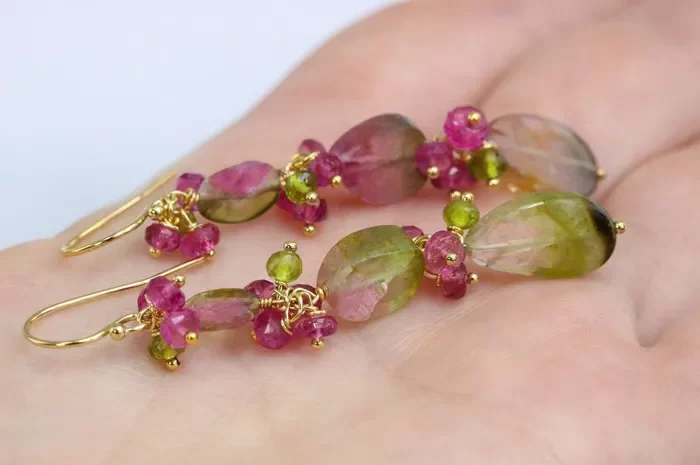Tourmaline is a fascinating gemstone, admired for its remarkable variety of colors and intriguing properties. As an increasingly popular choice for jewelry, it’s essential to understand whether tourmaline is durable enough for daily wear. This article delves into the physical properties of tourmaline, its suitability for different types of jewelry, and practical advice for care and maintenance to ensure longevity.
Understanding Tourmaline
Composition and Structure
Tourmaline is a complex borosilicate mineral that includes elements such as aluminum, iron, magnesium, sodium, lithium, or potassium. This complex composition results in a wide range of colors, making tourmaline one of the most colorful gemstones in the world. The structure of tourmaline is trigonal, often forming elongated, prismatic crystals that are well-suited to cutting and polishing for gemstones.
Varieties of Tourmaline
Tourmaline comes in a spectrum of colors, each variety having its unique appeal and name:
Elbaite: The most common variety, known for its vivid colors like pink, red (rubellite), blue (indicolite), and green.
Schorl: The black variety, rich in iron, known for its opaque and dense appearance.
Dravite: Usually brown to yellowish-brown, containing magnesium.
Liddicoatite: A rare variety with complex and multicolored zonations.
Each variety’s color is due to the presence of different trace elements, making tourmaline highly sought after by collectors and jewelers.
The Durability of Tourmaline
Mohs Hardness Scale
Tourmaline ranks between 7 and 7.5 on the Mohs hardness scale. This scale measures a mineral’s ability to resist scratching, with 10 being the hardest (diamond) and 1 being the softest (talc). A hardness of 7 to 7.5 means that tourmaline is relatively hard and can resist scratches from substances with a lower hardness. However, it is still susceptible to scratching from harder materials like quartz or diamond.
Toughness and Tenacity
While hardness measures scratch resistance, toughness refers to a gemstone’s ability to resist breaking, chipping, or cracking. Tourmaline’s toughness is generally considered fair to good. It is less prone to cleaving or fracturing compared to more brittle gemstones, such as emeralds. However, tourmaline can still chip if struck hard or subjected to sharp blows, especially along its crystal growth lines.
Stability
Tourmaline exhibits good stability, meaning it can withstand exposure to light and most chemicals without significant damage. However, some varieties, particularly those with intense color saturation like rubellite, may show slight fading over time if exposed to strong, prolonged sunlight.
Tourmaline in Jewelry
Suitability for Different Jewelry Types
Tourmaline’s hardness and relative toughness make it suitable for various types of jewelry, but some considerations are essential for daily wear pieces.
Rings: Tourmaline rings can be a stunning choice for their vibrant colors. However, rings are exposed to more wear and tear compared to other jewelry types. It is advisable to choose protective settings, such as bezel or halo settings, which offer better protection against knocks and scratches.
Earrings: Tourmaline earrings are generally safe for daily wear since they are less likely to be subjected to hard impacts. Studs and drop earrings showcase tourmaline beautifully while maintaining its integrity.
Pendants and Necklaces: Tourmaline pendants and necklaces are excellent for daily wear. The gemstone is less likely to encounter damaging impacts in these jewelry forms. Opt for settings that protect the stone, especially if the pendant is likely to swing and hit surfaces.
Bracelets: Bracelets are more prone to impacts and abrasion. If you prefer tourmaline bracelets, consider designs that encase the stones securely, minimizing exposure to potential damage.
Settings and Mountings
The choice of setting plays a crucial role in enhancing the durability of tourmaline jewelry. Protective settings such as bezels or half-bezels surround the gemstone, offering better protection against impacts. Prong settings can also be used but should be monitored for any signs of wear, as loose prongs can increase the risk of the gemstone falling out or getting damaged.
See Also: Precautions After Wearing Tourmaline
Care and Maintenance
Regular Cleaning
To keep tourmaline jewelry looking its best, regular cleaning is essential. Use a soft brush, mild soap, and lukewarm water to gently clean the gemstone. Avoid harsh chemicals and ultrasonic cleaners, as they can potentially damage the stone or the setting.
Storage
Proper storage is crucial to prevent scratches and other damage. Store tourmaline jewelry separately in a soft pouch or a lined jewelry box. Avoid storing it with harder gemstones, such as diamonds or sapphires, which could scratch the tourmaline.
Professional Check-ups
Periodic professional check-ups by a jeweler are recommended to ensure the settings are secure and the gemstone is in good condition. This is especially important for rings and bracelets that experience more wear.
Conclusion
Tourmaline is undoubtedly a beautiful and versatile gemstone, offering a stunning array of colors and considerable durability. While it may not be as hard or tough as diamonds or sapphires, with proper care and thoughtful design choices, tourmaline jewelry can certainly be enjoyed daily.


